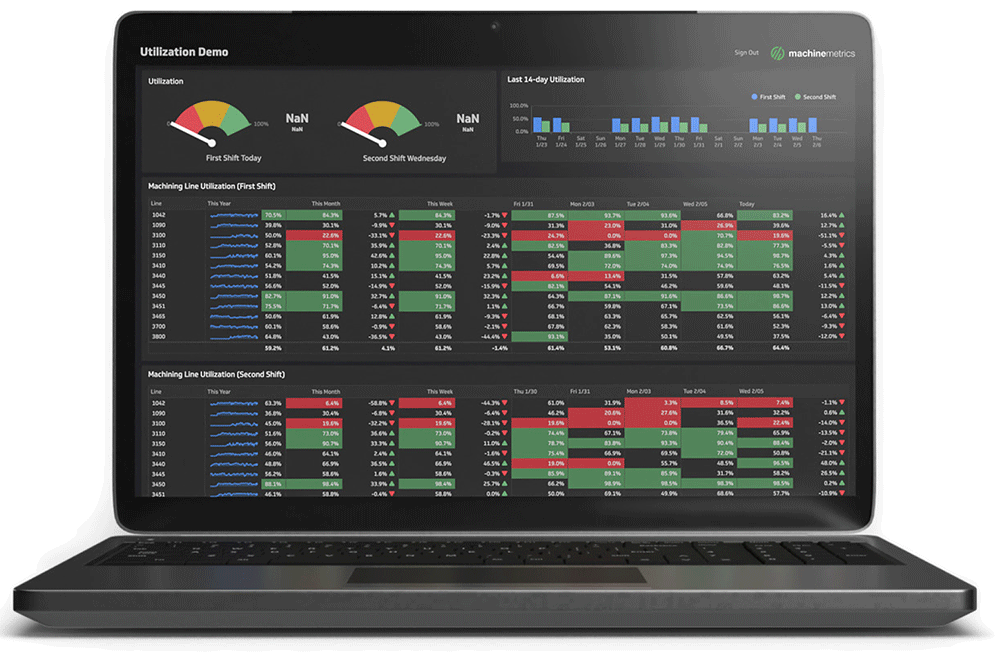
Federal Gear Enables IIoT Platform with MachineMetrics
Matthew Jaster, Senior Editor
Digital manufacturing is not just a ‘Matrix-like’ sequence of computer codes and programming magic. The gear industry cannot snap its collective finger and become a frontrunner on IIoT solutions overnight. There is a very extensive ‘to-do’ list in order to bring all your mechanical, electrical, and smart interfaces into a single, cohesive package. There is a machining component to the digital factory, for example, and you will find MachineMetrics —located in Northhampton, MA — at the center. The company created an industrial IoT platform designed for discrete manufacturing that connects and captures data from any machine regardless of the age or the name on the machine tool.
This technology allows manufacturers to measure, analyze, and optimize the performance of every machine on the shop floor, providing real-time data that the manufacturer can utilize to increase productivity, ramp up capacity and become more competitive. Who would not want an edge — or at the very least a head start—in the race to digital manufacturing? The Flexibility Factor Federal Gear & Machine—Eastlake, OH—has been an official member of the AGMA since 1927. They occupy a 22,000 square foot facility in the eastern suburbs of Cleveland, Ohio and offer both gearing and machining solutions. The company continues to focus on providing exceptional value to its customers by providing unique products and services tailored to customers’ individual needs, a philosophy that has remained consistent since the company was founded in 1914. With an emphasis on quality and flexibility, Federal Gear & Machine regularly examines its production schedule to see where the company can make improvements.
“We had a specific need to get more accurate information off the shop floor,” said David Hegenbarth, president, Federal Gear & Machine. “When I asked operators what the cycle time was for a specific job their answers would not jive with their actual production. We were losing production time but could not identify why. We needed to better utilize our capacity and minimize downtime.” Federal Gear investigated several different machine monitoring solutions from simple ones that only monitored if the machine was running or not, to complex systems that required significant hardware and software implementation. “MachineMetrics offered a simple implementation with significant data gathering capabilities. It may be overkill for what we need now, but as we grow, we will utilize increasingly what MachineMetrics has to offer. This — combined with fact that they could interface with different ERP and accounting packages — made it the most powerful and flexible solution we reviewed,” Hegenbarth said.
Federal Gear ended up selecting Machine Metric’s Machine Data Platform to use out of the box applications and workflows to automate processes to examine bottlenecks and production challenges.

Measuring and quantifying machine data is essential to remain competitive in manufacturing today. Photos courtesy of MachineMetrics .
“They started their analytics journey at the very beginning,” said Graham Immerman, vice president of marketing at MachineMetrics . “We call this ‘descriptive analytics’ where we focus on what is really happening in the factory. Real-time visibility like this creates instant performance improvements.”
Additionally, Federal Gear wanted their machine operators to become more involved in the continuous improvement process. “Our interfaces allowed everyone to participate in the data analytics to understand what was happening on the shop floor and how could it be improved,” Immerman added.
Results came quickly and were extremely satisfying, according to Hegenbarth. Once Federal Gear installed the system and set up the individual monitoring requirements, the machines began collecting data immediately.
“We are now able to monitor and quantify our machine performance. We can highlight the cause of downtime, address these issues, and minimize them. This allows us to recover capacity and be more productive. Our operators can see where they are losing time and make adjustments on their own to improve their production rates,” Hegenbarth said.
By highlighting downtime and capturing quality issues with data companies, Federal Gear can utilize real data to monitor and improve all operations. “We are no longer relying on gut feelings and operators’ memories. We have all the data at our disposal,” Hegenbarth said.
With the successful implementation of MachineMetrics platform, Hegenbarth will continue to evaluate Federal Gear’s operations and install MM solutions on new machines where they believe data collection will allow the organization to improve throughput.
The move to a collected and seamless digital factory floor is happening across the globe, but there are many factors that will determine how these solutions will thrive in an area like gear manufacturing. Perception being one of the greatest challenges.
“Convincing operators this is not a punitive or big brother type system, for example,” said Hegenbarth. “Operators must feel that this is a tool to assist them do better, and if they do better the company does better.”
Immerman believes ‘people’ are the greatest challenge to digital transformation. “Companies lack the skilled labor necessary to do the jobs that are needed. They also don’t have any mechanisms in place to capture the experience and knowledge lost from workers that retire. These factors tend to create inefficiencies on the shop floor.
These can effect every component of the company from pricing to production to delivering goods.”

MachineMetrics Utilization Reporting.
The goal then is to remove the burden of non-essential manual tasks and decision-making for manufacturers. This is essentially what MachineMetrics offers its customers.
“We’re not just throwing things on dashboards or reports,” Immerman said. “Manufacturers need tasks to be automated so they can focus on what they do best which is innovating product to process, plain and simple.”
This process starts with the machine assets as well as the personnel.
“Despite all the buzzwords you hear from marketing personnel on IIoT solutions, the truth is many organizations are not using the data they already have—from their machines or the operators running them — to unlock value quicker and create immediate productivity gains,” Immerman added.
So why in 2021 is an area like machine utilization so low in manufacturing?
“First, they’re not using analytics or data to drive decisions. Second, manual data entry can create all sorts of misunderstandings to what is actually taking place during production. And the worst culprit might be that many organizations are simply living in a state of reactivity.”
Immerman suggests that when all these manufacturing systems can’t connect, you literally cannot connect the dots. Manufacturers still use calendars to maintain their machines. They can’t identify process inefficiencies of setups or changeovers. They have machines on their shop floors that run out of material and sit idle for hours on end.
“Our job is to create solutions to these challenges that are user-friendly and will let the personnel on the shop floor focus on much more important tasks and priorities,” Immerman said.
“ They started their analytics journey at the very beginning,” said Graham Immerman, vice president of marketing at MachineMetrics . “We call this ‘descriptive analytics’ where we focus on what is really happening in the factory. Real-time visibility like this creates instant performance improvements.”
Since implementation, Hegenbarth has watched his personnel become more involved in every aspect of the shop floor.
“I have had operators show me data where they have downtime to justify a new tool or fixture so they can improve their production,” he said. “Proper incentive systems for individuals and departments need to be established to improve machine utilization.”
Federal Gear currently has a mix of dedicated manual and CNC machines. In the future, the manual machines will fade away and be replaced with new flexible CNC machines with automation and robotics.
“The key will be the ability to be flexible and adapt to ever changing needs and markets. If your machines are capable of manufacturing gears and aerospace parts, you are able to pivot your business to new opportunities utilizing the assets you already have,” Hegenbarth said.
All this information and knowledge is right there on the shop floor for the taking if the company has the wherewithal to acquire it.
Fg-machine.com
www.machinemetrics.com